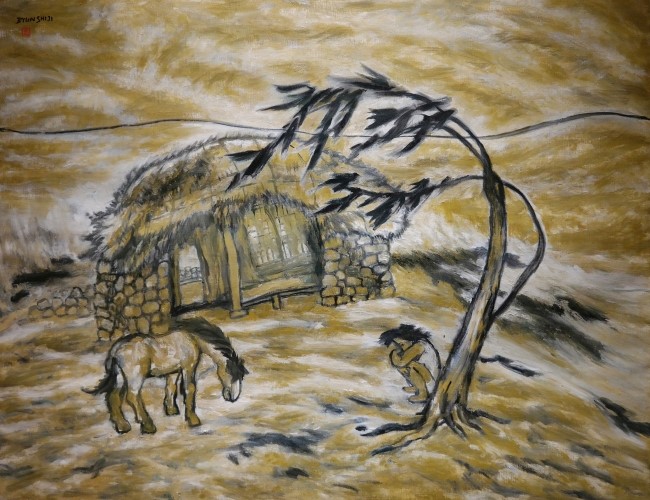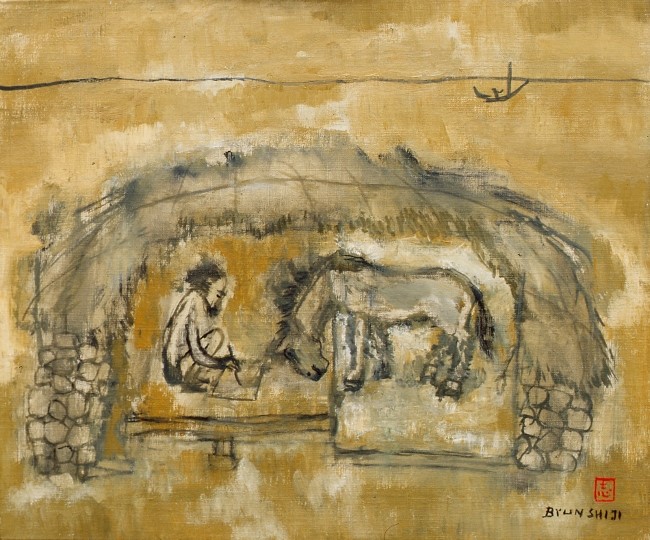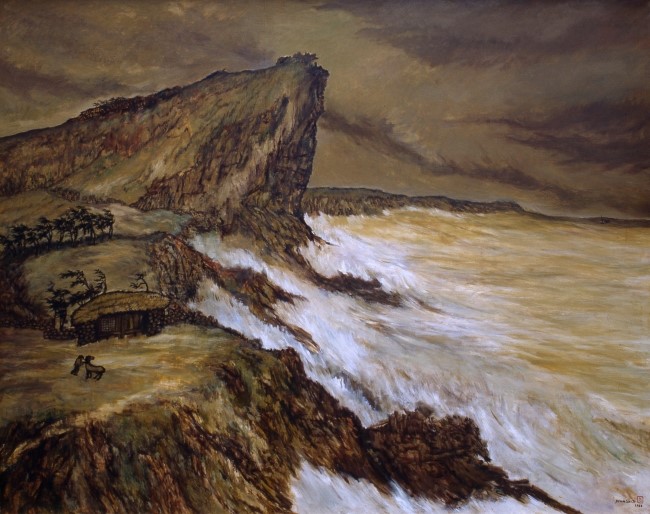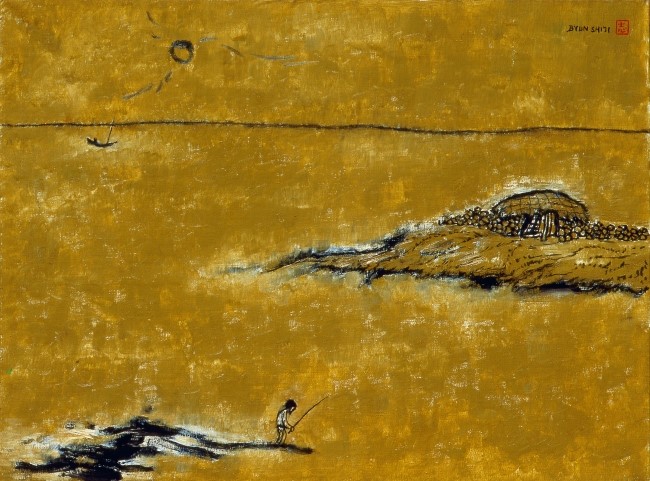| |
 |
|
| ▲ Artist Byeon Si-ji’s oil painting, Tempest (1990). Rough strokes and heavy shades of brown show that the work belongs to his earlier period, among the “Jeju Days” series. The slanted thatched-roof house with stone walls and bent pines branches provide evidence of harsh winds. After 2000, he mostly painted peaceful works filled with tinges of gold. |
His paintings sold well.
Japanese people loved the portraits by a young Joseon artist, who won the grand prize of Japan’s most renowned art contest at the youngest age. When he returned to Korea and created detailed landscape art depicting the old palaces in Seoul, the art dealers immediately sold them to the big market in Japan. In his middle age, Byeong headed to Jeju all by himself, deserting the stable mode of living. This is when flights between Seoul and Jeju were available once a week. His life of self-exile was lonesome, the clay-colored paintings didn’t sell, but he is now remembered as a Jeju artist.
Byeon’s aesthetic transformations were in line with residential relocations. He worked mostly on portraits during “Japan Days (1947-1957),” hyperrealistic depictions of ancient palaces in “Seoul Days (1957-1975),” and ink drawings on clay-colored paper illustrating Jeju’s primitive life in “Jeju Days (1975-2013).”
| |
 |
|
| ▲ Together |
Born in Seogwipo-si, Jeju in 1926, Byeon moved to Japan at age 6 with his parents. After graduating from Osaka Art School, he became the youngest winner of the grand prize from Japan’s Koufukai Competition at 22 years old. In his lavish twenties, he mostly worked on warm-toned seated portraits. Seated portraits were the popular item of the day in Japan’s art world. Once he comes to Seoul, Byeon focuses on ancient palaces. As opposed to the newly modernizing urban space, he paid attention to the palaces that retain the Korean aesthetics. The delicate, elaborate style added almost equal number of roof tiles as in real life.
| |
 |
|
| ▲ Typhoon (1982) |
However, his Jeju Days paintings become extremely simple. To Byeon, Jeju was an island of lights and wind. In his previous interview with Jeju Weekly, Byeon remarked, “When I first stepped outside the airport, the sunlight shone fiercely. Everything seemed to be yellowish brown. That was the color of Jeju.” Jeju is indeed a windy island, where the seeds you sow blow away with the soil. The source of motion in his paintings is this wind. In the ferocious waves, thatched houses and stone walls on the verge of collapse, the wavering skirts of men and women who await their loved ones, the deteriorating mane of ponies, and the fluttering wings of crows, we can see the presence of wind. This is the reason he is dubbed, “the artist of storm.”
| |
 |
|
| ▲ Village by the Sea |
The atmosphere sensed in his usage of colors and topics distinct to Jeju is the solitude and wait of the island. In each painting, a man appears with either hunched back or a cane, reminding the spectator that the landscape is not for observation, but a place of residence.
Art critic Kim Yu-jeong explained, “Byeon, who used to remark that the natural features is the essence of art, discovered the crux of Jeju and expressed the island of primeval life, barren conditions, and suffering history in temperate colors. He stylized ‘Jejuism,’ distinct from the aesthetics of the mainland Korea.”
In today’s international tour destination Jeju, his portrayal of the island no longer exists. But people discover Jeju’s distinct aesthetic appeal from his paintings. The Smithsonian in the United States is exhibiting two of Byeon’s paintings on lease, for ten years since June 2007. In 1997, search engine Yahoo selected Byeon as one of the “Top 100 Global Artists since Renaissance.”
Byeon Si-ji passed away on June 8, 2013 due to chronic conditions. The city of Seogwipo administered an official funeral for him. |























